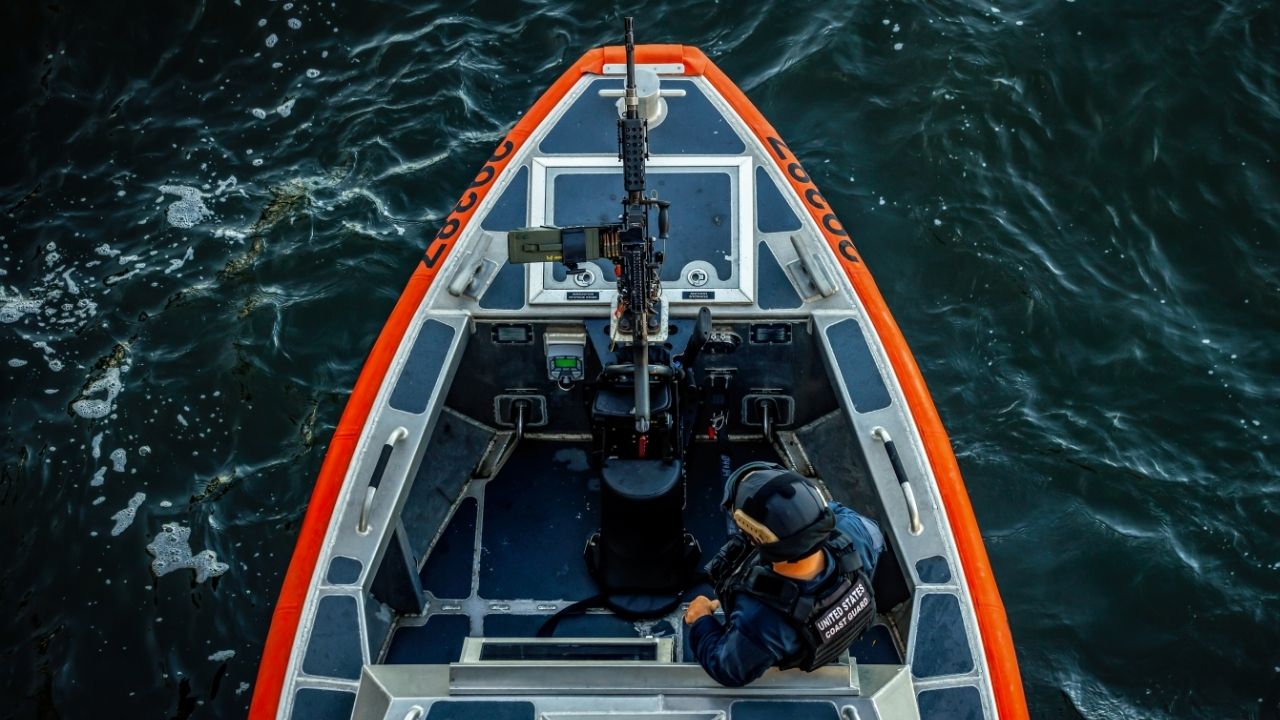A member of the Coast Guard patrols the waterways near President Donald Trump’s Mar-a-Lago resort in Palm Beach, Fla., Dec. 19, 2024. The Coast Guard is redefining how it views harassment across the service, discarding the concept of “hate incidents” and recasting symbols of hatred, including nooses and swastikas, as potentially “politically divisive.” (Scott McIntyre/The New York Times)
Share
|
Getting your Trinity Audio player ready...
|
The Coast Guard is redefining how it views harassment across the service, discarding the concept of “hate incidents” and recasting symbols of hatred, including nooses and swastikas, as potentially “politically divisive.”
In the past, the display of such symbols was unambiguously cited in policy as “incidents of hatred and prejudice” that “have no place in the Coast Guard.”
But the revised edition of the policy, which goes into effect next month, raises the bar for proving that displaying hate symbols in public merits punishment.
The new instructions, described in a document titled “Harassing Behavior Prevention, Response and Accountability,” was signed Nov. 13 by the Coast Guard’s assistant commandant for personnel, Rear Adm. Charles E. Fosse.
The policy acknowledges that hate symbols, including “representations of supremacy, racial or religious intolerance, or other bias,” can “marginalize segments of our work force.”
But displaying them in public, it said, will be considered “divisive” only if they affect “good order and discipline, unit cohesion, command climate, morale or mission effectiveness.”
Displays of symbols “widely identified with oppression or hatred” in private spaces outside public view are specifically allowed under the new guidance, the document said.
The service’s acting top officer, Adm. Kevin E. Lunday, insisted it was not changing the handling of displays of such symbols. In response to The Washington Post’s reporting on the policy’s existence, he said in a statement Thursday that any display, use or promotion of symbols like nooses and swastikas “will be thoroughly investigated and severely punished.”
Under the revisions, gender identity will no longer be considered “a protected characteristic.” In January, President Donald Trump signed an executive order that barred transgender people from serving in uniform.
Harassment in the service, the new directive says, must be based on race, sexual orientation, national origin, physical or mental disabilities or parental status, among others.
But harassment must be “severe or pervasive” to be punishable, the policy says. To meet that standard, the service will apply a “reasonable person standard” test in which another person is hypothetically exposed to the same circumstances as the victim to help determine whether he or she has suffered harm.
As a branch of the armed forces, men and women in the Coast Guard are subject to the Uniform Code of Military Justice, even as the service falls under the Department of Homeland Security.
Leaders must determine that the evidence rises above the “preponderance of the evidence” standard used for nonjudicial punishments, but less than the “beyond the shadow of a reasonable doubt” standard for criminal cases heard by courts-martial.
Victims to Report Incidents Within 45 Days
The instruction requires victims to report incidents of harassment within 45 days, unless they are of a sexual nature, though it allows for some discretion in reporting after more time has passed.
Leaders must report such incidents up their chain of command within 48 hours, however, if there is “the potential for congressional or media interest related to a report of harassing behavior.”
It also takes up the cause of hazing, which Defense Secretary Pete Hegseth has championed as a way to bring about what he calls a “warrior ethos” in the armed forces. Under the definition provided by the Coast Guard, hazing — which can include physical violence — can have “a proper military or other governmental purpose.”
The policy, however, maintains a ban on displays of the Confederate battle flag, except when they appear in artwork and historical materials.
“The Coast Guard remains unwavering in its commitment to fostering a safe, respectful and professional workplace,” Lunday said in his statement. “Symbols such as swastikas, nooses and other extremist or racist imagery violate our core values and are treated with the seriousness they warrant under current policy.”
On Thursday night, the Coast Guard announced a memorandum signed by Lunday saying that the service prohibits public displays of hateful symbols, but did not address Fosse’s earlier instruction that permitted their display in private.
Lunday assumed his current role after Trump fired his predecessor, Adm. Linda L. Fagan, without explanation within 24 hours of his inauguration in January.
Fagan was the first female officer to lead the Coast Guard.
Seth Levi, the chief strategy officer at Southern Poverty Law Center, a nonprofit civil rights group, called the new policy “a national embarrassment” and said the administration was creating a hostile environment for minorities to continue their service in the Coast Guard.
“If it’s not a softened stance, why did they change the existing language?” Levi said. “Swastikas are universally recognized as a symbol of the Nazi Party, genocide and antisemitism, and nooses are symbols of lynchings and racial terror.”
He added, “I don’t think there’s any ambiguity about that.”
—
This article originally appeared in The New York Times.
By John Ismay and Minho Kim/Scott McIntyre
c. 2025 The New York Times Company
RELATED TOPICS:
Categories



















